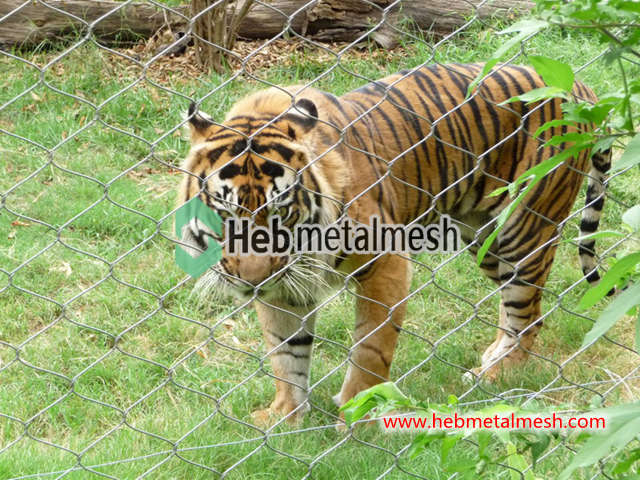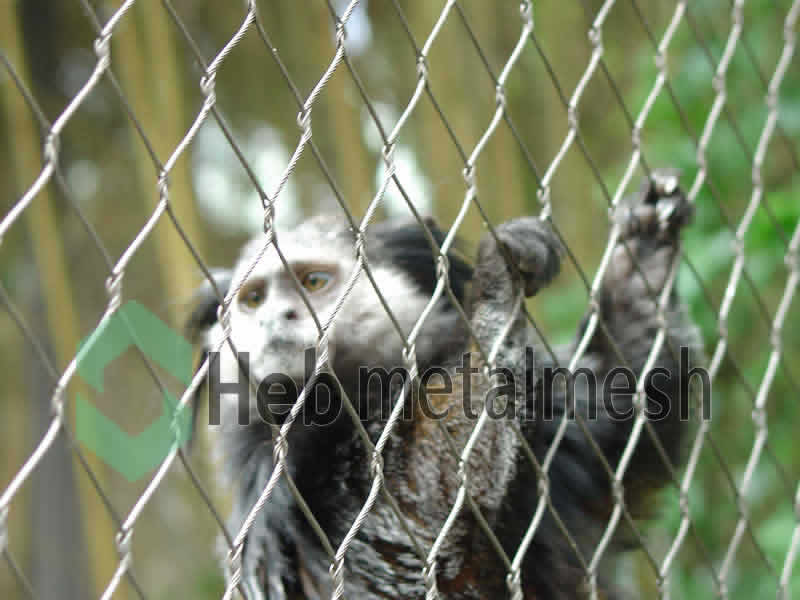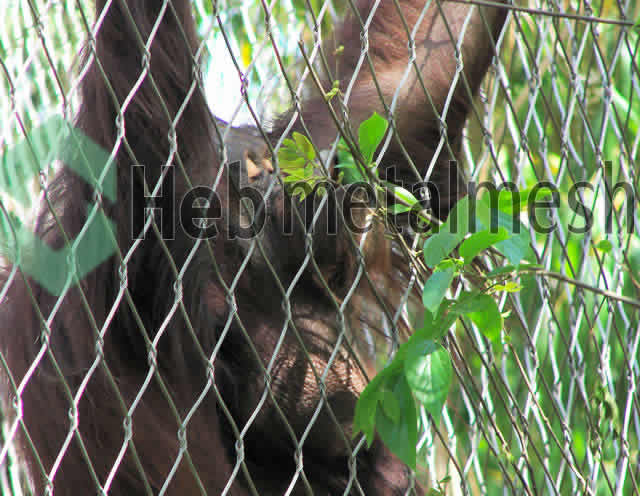Introduction to Zoo Barriers
Zoo barriers are essential structures utilized in animal enclosures designed to provide a safe and secure environment for both the animals and visitors. Their primary purpose is to prevent direct contact between zoo animals and the public, ensuring the safety of both parties while allowing for an immersive viewing experience. These barriers serve multiple functions, including confinement, protection, and maintaining the integrity of the animal habitats.
There are various types of zoo barriers employed by facilities to achieve these objectives. Common examples include glass walls, fences, moats, and, increasingly, stainless steel netting. Each type of barrier presents its own advantages and disadvantages, which facilities must carefully consider. For instance, glass barriers offer outstanding visibility and an unobstructed view of animals, but they can be high maintenance and may require additional safety measures to prevent breakage. On the other hand, moats provide a naturalistic feel but may not be feasible in every environment due to landscaping and water maintenance requirements.
The choice of materials is crucial when constructing a zoo barrier. Steel, especially stainless steel, is favored for its durability and resistance to weathering, such as rust formation, making it an optimal choice for long-lasting solutions. The aesthetics of the barriers also need to be taken into account, as they contribute to the overall visitor experience. A well-designed barrier can enhance the visual appeal of an exhibit while ensuring safety. Thus, the use of stainless steel netting, which combines strength with a lesser visual obstruction, can provide an effective solution and is increasingly popular in modern zoos. Without proper consideration of design, materials, and safety standards, the primary objectives of zoo barriers may not be fully achieved, which could pose risks to both animals and visitors.
Why Stainless Steel Netting is Ideal for Zoo Barriers
When it comes to constructing effective zoo barriers, the choice of materials plays a crucial role in both the safety of the animals and the experience of the visitors. Stainless steel netting emerges as a preferred option for numerous compelling reasons. Its unparalleled durability ensures that it can withstand the rigors of the outdoor environment, far outlasting alternatives made from traditional materials such as wood or plastic, which may decay or break down over time.
One of the key advantages of stainless steel netting is its resistance to weather elements. Unlike other materials that may degrade under exposure to rain, sun, or extreme temperatures, stainless steel maintains its integrity, thereby providing a reliable barrier that remains functional throughout the year. This resilience translates to lesser maintenance costs and less frequent replacements, making stainless steel netting a cost-effective choice in the long run.
Moreover, the aesthetic appeal of stainless steel netting cannot be overlooked. Its sleek and modern appearance blends seamlessly into various environments, ensuring that the focus remains on the animals while providing a safe enclosure. Unlike solid barriers that can obstruct views, stainless steel netting allows for an unobstructed sightline, enabling visitors to observe wildlife closely, which enhances their educational experience.
Another important factor is safety. Stainless steel netting can be customized in terms of mesh size to ensure that animals stay securely contained while still allowing for air circulation and visibility. This adaptability greatly assists in creating a barrier that matches the specific requirements of different species, resulting in an effective and safe enclosure.
In summary, the multitude of advantages offered by stainless steel netting—its durability, weather resistance, aesthetic values, and safety features—makes it an ideal material for zoo barriers. As zoos continue to evolve in their approaches to animal care and visitor experience, stainless steel netting stands out as a forward-thinking solution to ensure both safety and satisfaction.
Hebmetalmesh: Leading Manufacturer of Stainless Steel Netting
Hebmetalmesh stands as a prominent name in the world of stainless steel netting manufacturing, recognized for its commitment to quality and innovation. Established with a vision to provide durable and reliable solutions, the company has carved a niche for itself in the industry, catering to various needs including effective zoo barriers. By prioritizing high-grade materials and advanced production techniques, Hebmetalmesh has earned a reputation as a trusted partner for clients seeking superior netting solutions.
The manufacturing processes at Hebmetalmesh are characterized by precision and efficiency. The company employs state-of-the-art machinery and adheres to stringent quality control measures to ensure that every product meets the highest standards. The production team consists of skilled professionals who are well-versed in the intricacies of stainless steel netting fabrication. Their expertise plays a crucial role in developing flexible handwoven stainless steel netting, which is essential in applications such as zoo barriers, where safety and visibility are paramount. By focusing on quality craftsmanship, Hebmetalmesh ensures that their products provide not only functionality but also aesthetic appeal.
Hebmetalmesh’s specialization in creating handwoven netting sets it apart from other manufacturers. The flexibility of this type of netting makes it suitable for various applications, particularly in environments where customization is vital. For instance, the zoo barrier solutions offered by Hebmetalmesh are designed to accommodate different species of animals while ensuring the safety of both wildlife and visitors. By blending functionality with creativity, the company delivers netting solutions that enhance the overall experience within zoo environments. Through its dedication to excellence, Hebmetalmesh continues to lead the way in providing effective stainless steel netting for diverse applications, solidifying its status as a key player in the market.
Types of Zoo Barriers: Focus on Animal Enclosures
Zoo barriers play a crucial role in the safety and well-being of both animals and visitors. Various types of barriers are designed to suit the specific needs of different species, ensuring effective containment while providing a clear view for guests. Among these, monkey barriers, primate barriers, tiger barriers, and aviary barriers stand out due to their unique design considerations and requirements.
Monkey barriers typically consist of materials that can withstand the agility and strength of these agile animals. Stainless steel netting is increasingly utilized in these barriers due to its strength and durability, ensuring that the barrier remains intact against climbing and swinging activities. This type of zoo barrier allows for ventilation and visibility while minimizing the risk of escape or injury.
Primate barriers require similar considerations as monkey barriers but often involve additional complexities due to the intelligence and dexterity of these animals. Enclosures might feature stainless steel mesh in combination with glass or solid walls to enhance safety. The transparent components allow for unobstructed viewing while still providing a secure zoo barrier that discourages escape. The selection of materials here is critical in promoting both safety and comfort for the enclosed primates.
Tiger barriers, on the other hand, must be robust enough to contain large, powerful felines. A commonly adopted design incorporates reinforced stainless steel fencing that not only serves as a visual barrier but also withstands significant physical force. The height and structural integrity of the barrier are paramount considerations. Stainless steel netting can complement these structures, especially when designed to prevent any potential for climbing or jumping.
Aviary barriers pose distinct challenges, as they must an enclosure that protects birds while allowing for an expansive aerial space. Stainless steel netting serves well here, minimizing visual obstruction and enabling birds to thrive in an environment that mimics their natural habitat. The strategic design of these barriers is vital in promoting healthy behaviors and enhanced visitor experiences.
Safety Features of Stainless Steel Netting Barriers
Stainless steel netting barriers play a crucial role in ensuring the safety of both animals and visitors at zoological facilities. The structural integrity of these barriers is paramount, as they are designed to withstand various environmental pressures while maintaining their form and function. The durable nature of stainless steel provides inherent strength, which is necessary to prevent breaches that could endanger animals or pose risks to the public. Unlike traditional barriers, stainless steel netting does not easily degrade, corrode, or become brittle over time, thus ensuring long-lasting safety for animal enclosures.
Moreover, the resistance of stainless steel netting to tampering or damage by wildlife is a significant advantage. Many animal species are known to test the limits of their environments, and a well-constructed netting barrier can withstand their attempts to gain access to restricted areas. The fine weave and robust design of stainless steel netting deter animals from climbing or breaking through, thereby reducing the risk of escapes or human-animal confrontations. This aspect is particularly crucial for high-risk species that may display aggressive behaviors when threatened.
In addition to its structural attributes and resistance to wildlife interaction, compliance with safety regulations is a fundamental characteristic of stainless steel netting barriers. Zoos must adhere to stringent guidelines set forth by governing bodies to ensure the well-being of the animals and the safety of visitors. Stainless steel netting has become a preferred choice for many institutions as it meets and exceeds these regulations, providing peace of mind for both zoo management and patrons alike. Utilizing stainless steel netting as zoo barriers promotes an environment where safety and wildlife preservation can coalesce, allowing for a more secure experience for all involved.
Aesthetic Appeal and Visibility
Stainless steel netting plays a crucial role in enhancing the aesthetic appeal of zoo environments while ensuring optimal visibility for visitors. In modern zoos, the design entails creating immersive and natural habitats for animals, which simultaneously provides a pleasant experience for guests. Utilizing stainless steel in the construction of zoo barriers allows for a sleek, contemporary look that integrates seamlessly with various landscapes. The gleaming surface of the netting not only conveys cleanliness but also symbolizes innovation in wildlife conservation efforts.
Moreover, the transparency of stainless steel netting ensures that visitors can view the animals closely without barriers obstructing their line of sight. This transparency enhances the overall experience, as guests can observe the animals’ behavior and interactions in a manner that feels intimate and engaging. The use of a zoo barrier that is both secure and visually appealing is critical in attracting more visitors and promoting wildlife education. A well-designed enclosure allows for up-close encounters with animals, fostering a deeper appreciation of wildlife.
Balancing safety with aesthetic considerations is a primary focus for many zoological institutions. While the requirements for safety are paramount—ensuring that both animals and visitors are protected—stainless steel netting provides a solution that satisfies these needs without sacrificing aesthetic qualities. The durability and strength of these materials ensure that they can withstand the rigors of daily use while maintaining their form and function. Furthermore, the reflective properties of stainless steel can even enhance ambient light, creating a serene environment conducive to relaxation and observation.
In conclusion, stainless steel netting offers an effective and appealing zoo barrier solution that underscores the dual objectives of safety and visitor engagement. By incorporating such materials into their designs, zoos can create environments that are visually pleasing while providing maximum visibility into the world of wildlife.
Installation and Maintenance of Zoo Barrier Netting
The installation of stainless steel netting as an effective zoo barrier requires meticulous preparation and adherence to best practices to ensure safety and longevity. Initially, it is vital to assess the zoo’s specific needs, taking into account the type of animals housed and their behavior. This evaluation will inform the necessary height, thickness, and mesh size of the netting. A complete site survey should also be conducted to identify suitable anchorage points and assess the landscape for any potential structural challenges.
Once preparation is complete, the installation process can begin. The first step involves establishing a robust framework to support the stainless steel netting. This may include vertical and horizontal supports made from durable materials. When securing the netting, it is essential to maintain proper tension to prevent any sagging, which can compromise the integrity of the zoo barrier. Various attachment methods, such as using wire ties, clamps, or hooks, can be employed, depending on the design and the specific requirements of the zoo environment. Special attention should be given to the corners and joining points, as these are critical for maintaining the structure’s overall stability.
Following installation, regular maintenance is required to ensure that the stainless steel netting remains effective and secure. Maintenance tasks should include periodic inspections for any signs of wear or damage, such as corrosion or weakening of the anchorage points. Cleaning the netting is also vital, as debris and organic materials can accumulate, impacting visibility and overall aesthetics. Furthermore, any damaged sections should be promptly repaired or replaced to uphold the safety features of the zoo barrier. By prioritizing both careful installation and diligent maintenance, zoos can sustain effective and long-lasting barriers that promote safety for both animals and visitors alike.
Case Studies: Successful Implementations of Stainless Steel Netting
Stainless steel netting has emerged as a premium choice for zoo barriers worldwide, exemplifying safety and durability while enhancing the visual aesthetics of animal enclosures. A notable instance is the installation at the San Diego Zoo, where Hebmetalmesh’s robust stainless steel netting successfully replaced traditional fencing. This decision not only improved the safety of both animals and visitors but also allowed for unobstructed views, creating a more immersive experience. The netting’s strength ensured that even larger animals could be securely housed without compromising the overall design of the exhibit.
Another significant implementation took place at the Bronx Zoo in New York, where Hebmetalmesh products were employed to create a more open habitat for diverse wildlife. The use of stainless steel netting as a zoo barrier provided necessary strength and flexibility while minimizing visual barriers. This enhancement facilitated a naturalistic setting, fostering animal behavior that aligns more closely with their natural habitats. Furthermore, the maintenance of the netting proved far less labor-intensive compared to previous materials, leading to lower operational costs for the zoo over time.
In Australia, the Taronga Zoo embraced the advantages of stainless steel netting for their aviary exhibits. The netting not only provided a secure environment for birds but also offered transparency that enriched the visitor experience. Guests were able to observe various species in flight without intrusive structures obstructing their view, reflecting the zoo’s commitment to an open and engaging wildlife experience. The netting’s resilient properties also ensured that animal safety was prioritized at all times, with no recorded incidents of escape or injury since its installation.
These case studies highlight the versatility and effectiveness of stainless steel netting as a zoo barrier. The successful implementations of Hebmetalmesh products across various renowned zoos demonstrate the balance achieved between safety, functionality, and aesthetic appeal in modern zoological designs.
Conclusion: The Future of Zoo Barriers
In reviewing the advantages of using stainless steel netting for zoo barriers, it becomes evident that this material is not only beneficial for enhancing the safety and security of enclosures but also instrumental in maintaining the well-being of both animals and visitors. Stainless steel netting offers numerous advantages, including strength, durability, and a degree of transparency that allows for better visibility into enclosures, fostering a connection between the animals and the public. The combination of these attributes positions stainless steel netting as an ideal choice in the evolution of zoo barriers.
As zoos continue to evolve in their approach to animal housing and visitor experiences, the future of zoo barriers seems poised for further advancements. Innovative designs will likely incorporate stainless steel netting, propelled by its ability to adapt to various enclosure sizes and shapes, while providing a formidable deterrent against escape or intrusion. Additionally, the aesthetic appeal of stainless steel netting can enhance the overall presentation of the exhibit, allowing designers to create visually engaging environments that prioritize animal welfare.
Considering the growing emphasis on conservation and the ethical treatment of wildlife, the role of stainless steel netting in zoo barrier designs will likely expand. Future trends may involve integrating advanced technologies, such as smart monitoring systems embedded within netting structures, to provide real-time feedback on animal behavior and enclosure integrity. Such innovations could further enhance safety and contribute to research on animal welfare.
In conclusion, as zoos strive to create more immersive and responsible environments for animals, stainless steel netting will remain at the forefront of zoo barrier solutions. This material not only offers practical advantages but also aligns with the overarching goals of modern zoological institutions aimed at fostering education, conservation, and respect for the natural world.
FAQs: Zoo Barrier
A1: Stainless steel provides superior strength and corrosion resistance, creating a durable and long-lasting stainless steel zoo barrier that ensures secure containment with minimal maintenance for a wide range of animals.
A2: Yes, we specialize in custom-designed stainless steel zoo barrier panels tailored to your exact project specifications, ensuring a perfect fit and optimal security for any animal enclosure.
A3: Our barriers feature robust construction with smooth surfaces, providing a secure and safe animal barrier for zoo enclosures that protects both animals and the public from harm.
A4: Absolutely. The high corrosion resistance of our stainless steel makes it an ideal weather-resistant zoo barrier mesh for aquatic and humid environments, ensuring long-term structural integrity.
A5: The black oxide stainless steel zoo barrier offers a low-glare, natural aesthetic that blends into habitat designs, reducing visual impact for a more authentic visitor experience while maintaining full durability.


